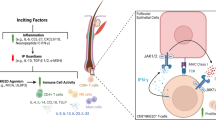Abstract
Genital human papillomavirus (HPV) is associated with the development of cutaneous malignant tumors, and differences in HPV subtypes are found in several cancers by histology. NF-κB is persistently activated in most cancers and confers a survival advantage to cancer cells, while A20 is a critical negative regulator of NF-κB and is an important tumor suppressor inactivated in B cell lymphomas. This study was undertaken to identify HPV types in cutaneous squamous cell carcinoma (SCC) as well as to determine whether the crosstalk of A20/NF-κB was involved in HPV-induced SCC. Overall, HPV positivity was observed to be 66.2 %, with HPV16 being most common followed by infection with HPV18. Out of 43 HPV-positive samples, 35 samples were positive for one or more high-risk HPV (HR-HPV) types, suggesting a high association of SCC with HR-HPV infection, while only five HPV infections were detected in 21 normal skin samples and low-risk HPV (LR-HPV) infection was the most common. Both A20 and NF-κB were overexpressed in HPV-positive SCC samples (56 vs 87.4 %) and were closely correlated with TNM stage and lymph node transfer, respectively. More interestingly, the expression of A20 and NF-κB was much higher in HR-HPV samples than in LR-HPV samples. These results suggest that the crosstalk of A20 and NF-κB may contribute to HR-HPV-associated tumor growth and metastasis of SCC and may be a novel therapeutic target for SCC in the future.



Similar content being viewed by others
References
Brantsch KD, Meisner C, Schönfisch B, Trilling B, Wehner-Caroli J, Rocken M, et al. Analysis of risk factors determining prognosis of cutaneous squamous-cell carcinoma: a prospective study. Lancet Oncol. 2008;9(8):713–20.
Peng H, He Q, Zhu J, Peng C. Effect of GSTM1 polymorphism on risks of basal cell carcinoma and squamous cell carcinoma: a meta-analysis. Tumor Biol. 2013;34(2):675–81.
Arron ST, Jennings L, Nindl I, Rosl F, Bouwes Bavinck JN, Seckin D, et al. Viral oncogenesis and its role in nonmelanoma skin cancer. Br J Dermatol. 2011;164(6):1201–13.
Zang W, Wang Y, Du Y, Xuan X, Wang T, Li M, et al. Differential expression profiling of microRNA and their potential involvement in esophageal squamous cell carcinoma. Tumor Biol. 2014;35(4):3295–304.
Boulet G, Horvath C, Broeck DV, Sahebali S, Bogers J. Human papillomavirus: E6 and E7 oncogenes. Int J Biochem Cell Biol. 2007;39(11):2006–11.
Sun SC, Cesarman E. NF-κB as a target for oncogenic viruses. Curr Top Microbiol Immunol. 2011;349(2):197–244.
James MA, Lee JH, Klingelhutz AJ. Human papillomavirus type 15 E6 activates NF-kappaB, induces cIAP-2 expression, and protects against apoptosis in a PDZ binding motif-dependent manner. J Virol. 2006;80(11):5301–7.
Pim D, Bergant M, Boon SS, Ganti K, et al. Human papillomaviruses and the specificity of PDZ domain targeting. FEBS J. 2012;279(19):3530–7.
Spitkovsky D, Hehner SP, Hofmann TG, Mlller A, Schmitz ML. The human papillomavirus oncoprotein E7 attenuates NF-kappa B activation by targeting the Ikappa B kinase complex. J Biol Chem. 2002;277(28):25576–82.
Opipari AW, Boguski MS, Dixit V. The A20 cDNA induced by tumor necrosis factor alpha encodes a novel type of zinc finger protein. J Biol Chem. 1990;265(25):14705–8.
Beyaert R, Heyninck K, Van Huffel S. A20 and A20-binding proteins as cellular inhibitors of nuclear factor-kappa B-dependent gene expression and apoptosis. Biochem Pharmacol. 2000;60(8):1143–51.
Zhang B, Guan CC, Chen WT, Zhang P, Yan M, Shi JH, et al. A20 inhibits human salivary adenoid cystic carcinoma cells invasion via blocking nuclear factor-kappaB activation. Chin Med J (Engl). 2007;120(20):1830–5.
Zhou XD, Yu JP, Liu J, Luo HS, Chen HX, Yu HG. Overexpression of cellular FLICE-inhibitory protein (FLIP) in gastric adenocarcinoma. Clin Sci (Lond). 2004;106(4):397–405.
Massi D, Tarantini F, Franchi A, Paglierani M, Di Serio C, Pellerito S, et al. Evidence for differential expression of Notch receptors and their ligands in melanocytic nevi and cutaneous malignant melanoma. Mod Pathol. 2006;19(2):246–54.
Aldabagh B, Angeles JG, Cardones AR, Arron ST. Cutaneous squamous cell carcinoma and human papillomavirus: is there an association? Dermatol Surg. 2013;39(1Pt1):1–23.
Burk RD, Kadish AS. Treasure hunt for human papillomaviruses in nonmelanoma skin cancers. J Natl Cancer Inst. 1996;88(12):781–2.
Dang C, Koehler A, Forschner T, Sehr P, Michael K, Pawlita M, et al. E6/E7 expression of human papillomavirus types in cutaneous squamous cell dysplasia and carcinoma in immunosuppressed organ transplant recipients. Br J Dermatol. 2006;155(1):129–36.
Baeuerle PA, Baltimore D. NF-kappa B: ten years after. Cell. 1996;87(1):13–20.
Chen Z, Yan B, van Waes C. The role of the NF-kappaB transcriptome and proteome as biomarkers in human head and neck squamous cell carcinoma. Biomark Med. 2008;2(4):409–26.
Fontaine V, van der Meijden E, de Graaf J, ter Schegget J, Struyk L. A functional NF-kappaB binding site in the human papillomavirus type 16 long control region. Virology. 2000;272(1):40–9.
Opipari Jr AW, Hu HM, Yabkowitz R, Dixit VM. The A20 zinc finger protein protects cells from tumor necrosis factor cytotoxicity. J Biol Chem. 1992;267(18):12424–7.
Boone DL, Turer EE, Lee EG, Ahmad RC, Wheeler MT, Tsui C, et al. The ubiquitin-modifying enzyme A20 is required for termination of Toll-like receptor responses. Nat Immunol. 2004;5(10):1052–60.
Kowalczuk O, Burzykowski T, Niklinska WE, Kozlowski M, Chyczewski L, Niklinski J, et al. Tumor Biol. 2014;35(5):4619–28.
Acknowledgments
This work was supported by the Youth Foundation of Natural Science Foundation Project of Jiangsu Province (No. BK2012153).
Conflicts of interest
None
Author information
Authors and Affiliations
Corresponding author
Additional information
Ya-Juan Tang and Ahmad Taha Khalaf contributed equally to this work.
Rights and permissions
About this article
Cite this article
Tang, YJ., Khalaf, A.T., Liu, XM. et al. Zinc finger A20 and NF-κB correlate with high-risk human papillomavirus of squamous cell carcinoma patients. Tumor Biol. 35, 11855–11860 (2014). https://doi.org/10.1007/s13277-014-2416-9
Received:
Accepted:
Published:
Issue Date:
DOI: https://doi.org/10.1007/s13277-014-2416-9




